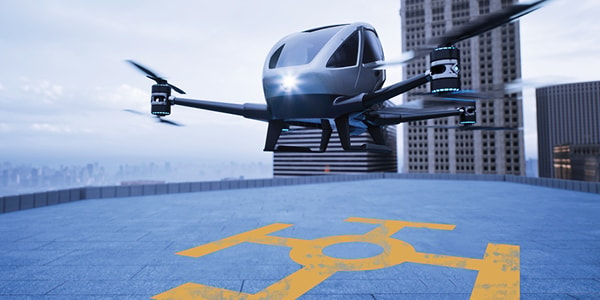FAA updates its blueprint for air taxis, urban air mobility

It’s been nearly three years, so a recalibration was inevitable. And this undoubtedly will not be the final update.
The future of flight has gotten some revised guidelines, as last week the FAA updated its blueprint for advanced air mobility services in urban areas. A swarm of eVTOL aircraft and air taxis are set to reach the sky in the coming years, ferrying small groups of passengers and cargo from airports and across cities.
In many cases, planners expect for areas not previously served by aviation to become reachable by air travel.
Developed by the FAA along with NASA and aviation industry stakeholders, the urban air mobility blueprint focuses on flights in and around urban areas. The broader concept of advanced air mobility fits a broader framework of airspace and destinations.
RELATED STORY: The FAA takes a small step into aviation’s giant leap – drafting the guidelines for powered-lift aircraft
As operations get underway, the FAA plans for air taxis and similar aircraft to operate in lower numbers before scaling. The usage will be primarily in a similar fashion to present-day helicopters, relying on existing routes, as well as helipads and some early vertiports now in planning stages.
“Pilots will communicate with air traffic controllers where required,” an introduction to the second draft of the blueprint states.
“As the number of operations increases, air taxis are expected to fly in corridors between major airports and vertiports in city centers,” it continues. “The complexity of the corridors could increase over time from single one-way paths to routes serving multiple flows of aircraft flying in both directions. Over time, these corridors could link an increasing number of routes between vertiports.”
RELATED STORIES:
FAA releases guidelines for vertiports development for AAM aircraft
United and Archer announce first eVTOL air taxi route in Chicago
As the framework evolves, the FAA expects the aircraft to become increasingly advanced as well, ultimately incorporating automation and real-time data sharing. With the integration of eVTOL aircraft and advanced air mobility, safety must be a top priority for the country, NBAA President and CEO Ed Bolen told Congress in February.
“We have the potential to continue to lead the next phase in the evolution in aviation with AAM, but competition with other nations to be first is fierce and rapidly advancing,” he said.
RELATED STORY: Aviation leaders call on Congress to do more for FAA
Revising the initial blueprint published in June 2020, this new wave of revisions from the FAA expands the document with greater detail on the elements of various conceptual components and their relationship to the field of urban air mobility.
“The UAM ConOps Version 2.0 is an iterative progression of work in the development of the concept that will be continued to mature through ongoing government and industry stakeholder collaboration,” writes Paul Fontaine, the FAA’s acting assistant administrator for NextGen. “Future editions of the UAM ConOps will provide a broader and more comprehensive vision of our shared partnership for UAM operations based on feedback and continued collaboration surrounding this iteration of the UAM ConOps.”
Access the full FAA Urban Air Mobility Blueprint here.

Recent Comments